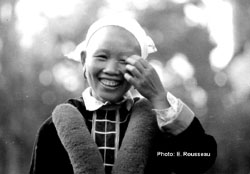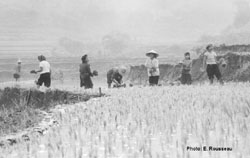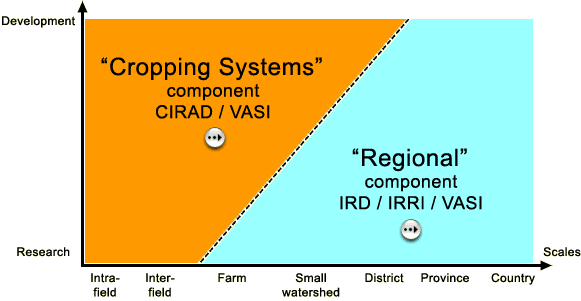|
 Origin
and General Orientations of the SAM Program Origin
and General Orientations of the SAM Program
In the uplands
of Northern Vietnam, increasing population pressure combined with privatization
of the economy, land redistribution and political reforms were the main
driving forces behind the rapid and profound land use changes which occurred
during the past decades. Lowland areas are now saturated while the development
of non-sustainable agricultural practices on the hillsides endangers fragile
upland ecosystems. These recent trends in land use changes plead for new
ways to produce that would be more respectful of the natural resource
base while covering increasing food needs.
 The
Mountain Agrarian Systems Program (SAM) started in 1998 with the main
objectives of improving (i) agricultural productivity (ii) natural resources
management and (iii) the living standards of highlands ethnic minority
groups. The SAM Program is made of two sub-programs. Based on a preliminary
agronomic diagnosis characterizing and explaining intra- and inter-field
heterogeneity, and ranking production limiting factors, the “Cropping
Systems” component identifies, adapts, tests, and extends improved
cropping systems from field to small watershed levels. The “Regional”
component aims at achieving a good understanding of the processes of land
use changes and their main driving forces from farm to provincial levels
prior to the introduction of technical and organizational innovations.
This component is complementary to the “Cropping Systems”
component as it identifies extrapolation keys to large geographic areas
of locally obtained research results, and offers new tools to facilitate
decision making in the field of rural development and sustainable natural
resource management in the uplands (cf. figure here below). The
Mountain Agrarian Systems Program (SAM) started in 1998 with the main
objectives of improving (i) agricultural productivity (ii) natural resources
management and (iii) the living standards of highlands ethnic minority
groups. The SAM Program is made of two sub-programs. Based on a preliminary
agronomic diagnosis characterizing and explaining intra- and inter-field
heterogeneity, and ranking production limiting factors, the “Cropping
Systems” component identifies, adapts, tests, and extends improved
cropping systems from field to small watershed levels. The “Regional”
component aims at achieving a good understanding of the processes of land
use changes and their main driving forces from farm to provincial levels
prior to the introduction of technical and organizational innovations.
This component is complementary to the “Cropping Systems”
component as it identifies extrapolation keys to large geographic areas
of locally obtained research results, and offers new tools to facilitate
decision making in the field of rural development and sustainable natural
resource management in the uplands (cf. figure here below).

|


